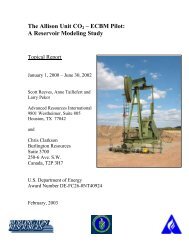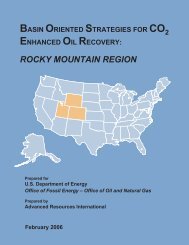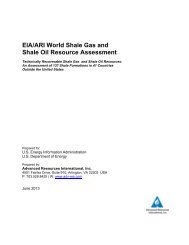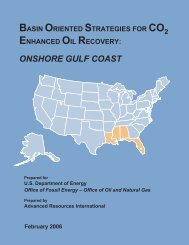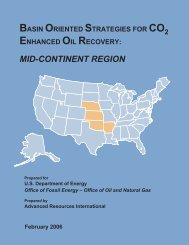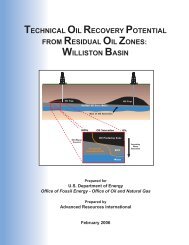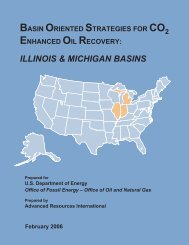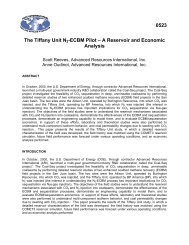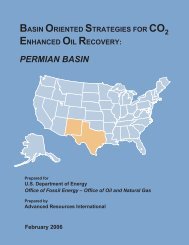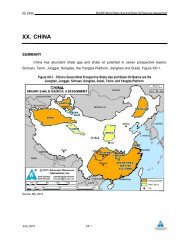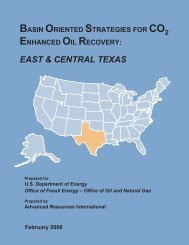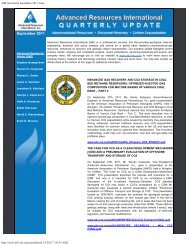Assessing Technical and Economic Recovery of Oil Resources
Assessing Technical and Economic Recovery of Oil Resources
Assessing Technical and Economic Recovery of Oil Resources
Create successful ePaper yourself
Turn your PDF publications into a flip-book with our unique Google optimized e-Paper software.
II. ORIGIN AND OCCURRENCE OF RESIDUAL OILZONESThe term residual oil zone (ROZ), as used in this study, does not include themore commonly known transition zone (TZ). Although <strong>of</strong>ten used interchangeably, thetwo terms describe different portions <strong>of</strong> an oil reservoir. All oil reservoirs have atransition zone, an interval tens <strong>of</strong> feet below the traditionally-defined producing oilwatercontact (OWC) where the oil saturation falls rapidly. The thickness <strong>of</strong> this intervalis controlled by capillary forces <strong>and</strong> the nature <strong>of</strong> the rock’s “wetting phase”, with lowerpermeability oil-wet rocks providing thicker TZ’s <strong>and</strong> water-wet rocks providing thinnerones.While all oil reservoirs have a transition zone, not all have a residual oil zone, asspecific hydrological or geological conditions need to have occurred to create a ROZ, asfurther discussed below. The great bulk <strong>of</strong> the ROZ will be at a residual oil saturation(similar to that after a conventional waterflood), tapering to near zero oil saturation atthe base. A typical reservoir oil saturation pr<strong>of</strong>ile is shown in Figure 1, <strong>Oil</strong> SaturationPr<strong>of</strong>ile in the TZ/ROZ: Adapted from a Wasson Denver Unit Well.The transition zone (TZ) is the upper portion <strong>of</strong> the reservoir interval just belowthe traditional OWC <strong>and</strong> produces both water <strong>and</strong> oil. The residual oil zone (ROZ) isgenerally the middle <strong>and</strong> lower portions <strong>of</strong> the reservoir interval below the traditionalOWC <strong>and</strong> produces primarily water.The reason that both terms - - residual oil zone (ROZ) <strong>and</strong> transition zone (TZ) - -are used in this report is to bring special attention to the abnormally thick ROZs that canexist for reasons beyond normal capillary effects. For example, if the original oil trappossessed a thick oil column in its geologic past <strong>and</strong> the lower portion <strong>of</strong> this oil columnwas tilted <strong>and</strong>/or invaded by water, this lower reservoir interval would have an oilsaturation much like that <strong>of</strong> the residual oil saturation in the swept zone <strong>of</strong> a water flood.In certain geologic settings, oil reservoirs can have an anomalously thick ROZ <strong>and</strong> thuscould contribute considerable additional CO 2 -EOR reserves.2-1 February 2006




